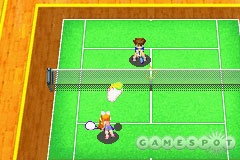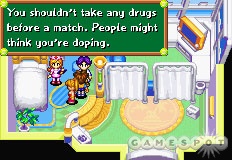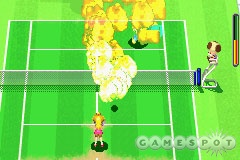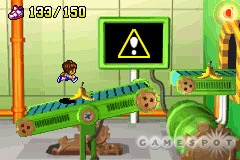Time and time again, Nintendo has demonstrated a talent for taking sports that are considered bland from a spectator's perspective and adapting them into lavishly produced and fun-filled video games. People that otherwise wouldn't pay a passing glance to sports like golf, soccer, tennis, and baseball have come to discover that games based on these sports are a thrill a minute when Mario and his cohorts are involved. The latest example of this phenomenon is Mario Tennis: Power Tour, a rousing tennis game for the Game Boy Advance that's thick with bells and whistles in every regard.

Nintendo and Camelot didn't set out to reinvent the wheel with Mario Tennis: Power Tour. Instead, what they've done is build upon the earlier Mario Tennis Game Boy Color game by upgrading the graphics and audio, expanding the single-player role-playing mode, increasing the selection of characters and minigames, and, to top it all off, incorporating gameplay aspects that were recently introduced in Mario Power Tennis for the GameCube.
Solo play modes include an RPG-style tour mode, an exhibition mode, and 18 different minigames. Some of the minigames aren't even tennis related this time around, like the treadmill game that's eerily similar to Donkey Kong. Various options can be adjusted for exhibition matches, including CPU difficulty, court location, and the number of games and sets per match. Multiplayer play is, of course, a major feature. Using a link cable or the GBA wireless adapter, you can join together two systems for singles play or chain together four systems for doubles play. Aside from all of those play modes, the game is further bolstered by its extensive character roster. In all, there are no fewer than 30 characters to pick from, each with its own stats and power shots.
For better or worse, the majority of characters and all of the minigames are locked from the get-go. To unlock them, you have to play through the single-player power tour mode. It basically picks up where the story mode in Mario Tennis GBC left off. Many of the old characters are now coaches, while two new recruits, Clay and Ace, have enrolled at the tennis academy to pick up the mantle and embark on the fast track toward challenging the world's best players. Their quest is set up like a tennis-themed role-playing game. There are numerous places to visit, many characters to talk to, minigames to practice on, and, of course, plenty of tennis matches to partake in. Clay and Ace even level up like typical RPG characters do, with experience points earned from matches and minigames going toward various primary and secondary skills of the player's choosing. Some minigames help Clay and Ace add power shots to their bag of tricks.

Having players work through the power tour mode isn't necessarily a bad thing, since it is meant to impart all of the game's intricacies from beginner to expert and beyond. Nonetheless, some players may be turned off by the slow pace at which unlockables become available (typically one per match), or they may just deem the entire quest too drawn out for its own good. Characters tend to grind progress to a halt by chatting at length on numerous occasions. Meanwhile, unlocking everything by getting through all three class levels and two main tournaments can easily take upwards of 15 hours.
Out on the court, Mario Tennis: Power Tour balances the necessary aspects of tennis with the outlandish sort of video-game-inspired nuances that make games like this fun to play. On the one hand, it's nice that aspects such as scoring, shots, and physics are all somewhat grounded in reality. On the other hand, the inclusion of curvy slices and unbelievable power shots gives the game an extra dash of excitement that traditional tennis doesn't have. The characters are speedy, the shots are fast, and the overall flow is conducive to quick volleys and finishing smashes. Also, much of the time, the CPU puts up a decent challenge. CPU opponents can be tricked into leaving their backs wide open or eating a smash to the face once in a while, but generally they try their best to return the ball or catch you leaning the wrong way.
Surprisingly, the controls are simultaneously intricate and easy to learn. You can perform basic topspin and underspin shots by pressing the A button or B button. If you need to dive for a ball, you can press the L button to add some distance to your character's lunge. Other shots, such as lobs, drop shots, and smashes, can be performed by first tapping one button and then the other, or by pressing two buttons at the same time. You can also build power and control into a shot by pressing the button early, and control the curve of the shot by holding left or right on the directional pad as the ball leaves the racket. Even the game's physics can be used to influence your racket skills, in that weaker shots tend to be hit while moving backward and stronger shots tend to be hit while moving forward.

Overall, gameplay hasn't changed much since Mario Tennis first appeared on the Nintendo 64 and Game Boy Color. The only addition of significance is that players now have the ability to perform power shots, which were introduced in the recently released GameCube game, Mario Power Tennis. Just that one change alone, however, is enough to make Mario Power Tennis and its Game Boy Advance counterpart, Mario Tennis: Power Tour, much more lively and compelling than their predecessors. Put simply, power shots are magically charged shots that can blast past the opponent or rescue a ball that you'd otherwise not be able to reach. You have to get a volley going to build up energy before you can use a power shot, but activating it is as easy as holding the right shoulder button and pressing A or B. These shots are visually pleasing because they cause all sorts of silly graphical effects that are fun to watch. Plus, they're welcome from a gameplay standpoint because they give players a better variety of exciting shots to take without breaking the game. Since power shots are easy to recharge and can be used by all characters, they're a frequently used and integral aspect of how the game is played. All of the Mario-centric characters have their own unique power shots, but you can unlock and choose specific power shots for your custom characters by playing through the minigames in the tour mode.
Multiplayer play is another selling point. Since the game is so much fun to play, you probably won't have any trouble convincing your friends to buy their own copies. Once you do, all you need is a link cable or a few GBA wireless adapters in order to join together two or four systems for singles or doubles play. There's a brief pause between setting up and getting into a match, but beyond that, the action is fast and lag-free.

In addition to being a joy to play, the game's presentation is a pleasure for both the eyes and ears. Wandering around the tennis academy in the tour mode has a look and feel similar to that of a full-fledged RPG, with a top-down viewpoint, colorful scenery, and big-headed characters that are reminiscent of games like Final Fantasy or Golden Sun. The beautifully orchestrated music that accompanies the goings-on in the tour mode sure doesn't hurt either. Out on the court, the character sprites aren't as roly-poly. In fact, they look like 3D renders that were turned into 2D sprites. There are so many different animations for every possible action, and they're all remarkably smooth. A low-key approach was taken with the courts themselves, in that they're sharply defined but not extravagantly detailed. All of the numerous miscellaneous visual effects, for things like light trails and explosions, help to enliven things, especially the intricate power-shot animations displayed by the Mario-themed characters. As for the audio, the music is light and the various sound effects suit the action. The referee comments and character vocalizations are a nice touch, too, even if the majority of characters just grunt and scream.
Once again, Nintendo has taken a sport that not everyone likes--in this case, tennis--and has transformed it into a fun-filled game that's not only suitable for fans of the sport, but also fine for players of any age. Between its involving gameplay and numerous play features, Mario Tennis: Power Tour will make a believer out of you.